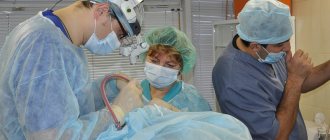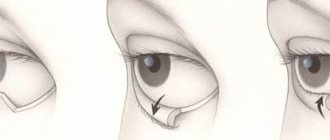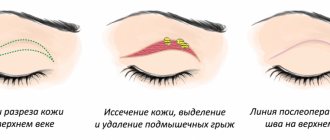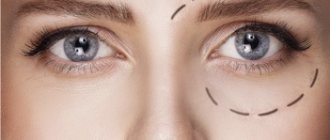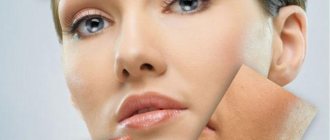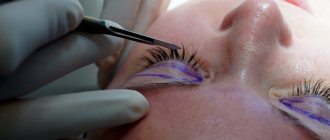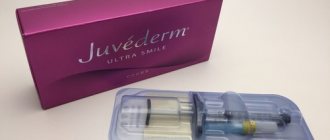Blepharoplasty is an operation to correct the shape and shape of the eyes, used to remove excess skin folds (eyelids) and any formations on their surface. Among the total number of plastic surgeries, a considerable share is accounted for by surgical correction of the eyelids and amounts to about 25%.
In this article
- What should be the normal recovery period after blepharoplasty?
- Consequences and complications of eyelid surgery
- Causes of swelling and bruising
- Methods for treating edema and hematomas after blepharoplasty
- Prevention of edema due to blepharoplasty
There are a huge number of indications and contraindications for this type of operation, which must be strictly observed when prescribing it. Often, it is non-compliance with preoperative preparation, the recommendations of an ophthalmologist, or a poorly performed operation that causes a number of unpleasant consequences.
One of them is considered swelling of the eyelids - a reaction to injury characteristic of any body, which manifests itself in the form of severe swelling of the skin around the eyes and its swelling. Normally, eyelid swelling subsides 7-8 days after blepharoplasty. And yet, it is often this reaction that becomes protracted and develops into a complication: bruises (hematomas) form in the area of the lower eyelids, which do not go away after a week or a month, while the upper eyelids completely close the eyes.
How to distinguish the normal swelling of the postoperative period from rapidly developing complications? How long can such swelling and bruising on the face last and is it necessary to deal with them? The answers to these questions lie in the nature of the operation and the causes of complications.
Let's take a closer look.
What should be the normal recovery period after blepharoplasty?
As statistics show, after eyelid surgery, the process of tissue restoration has a certain sequence, and practicing doctors note that the first week of the recovery period has a special gradation:
- In the first two days, mild or more intense swelling of the eyelids is observed. It gradually grows, and sometimes, in combination with it, voluminous, rich blue hematomas appear, sometimes affecting the cheekbones.
- On the third and fourth days, the swelling of the skin gradually goes away, and the color of the bruises changes to a paler color (green, yellow, brown), they become much smaller in size.
- By the end of the week, the swelling of the eyelids almost completely disappears from the face, but residual hematomas persist for some time. Asymmetry of the eyelids is clearly evident due to uneven absorption of fluid in the tissue cavity.
The further course of rehabilitation is less predictable: complete recovery after eyelid blepharoplasty can end either on the 20th day or by the end of the second month, and the external manifestations of the operation - swelling and bruising - can take much longer than the timeframe usual for ophthalmologists.
Diagnostics
The specialist makes a diagnosis after assessing the total information obtained from interviewing the patient and conducting all necessary examinations.
Interview and visual acuity testing (visometry)
The doctor may think about macular edema if you have:
- Characteristic combination of complaints
- Data on concomitant diseases that could become the basis for the development of edema (diabetes mellitus, etc.)
- Decreased visual acuity that cannot be corrected with glasses.
Visual field check
A feature of macular edema is the deterioration of central vision while maintaining normal peripheral vision. There are various techniques that a doctor can use to identify central vision problems. The most informative method is computer perimetry. With its help, areas of decreased clarity of central vision are identified, which are called central scotomas. The characteristic location of such a scotoma may indicate damage to the macula area.
Fundus examination
The condition of the macula is visually assessed using ophthalmoscopy and examination with a fundus lens. The first method allows you to get a general idea of the condition of the retina, the second - using a special lens and high magnification at the slit lamp - is suitable for a more detailed examination. Before the examination, the doctor will drop drops that dilate the pupil to achieve a better view of the macula.
FA (fluorescein angiography)
A technique that, using a special dye, identifies the area where fluid leaves the bloodstream due to increased permeability of the vessel wall. FA reveals the location of accumulation of this fluid in the retinal tissue, that is, it allows you to see the edema, its size and boundaries.
OCT or optical coherence tomography.
This method allows you to “scan” the retina, determining the thickness of all its layers, including in the macular area. OCT and FA provide the most information for diagnosing macular edema.
This is what an OCT image looks like
Macular edema on OCT
Consequences and complications of eyelid surgery
The side effects of blepharoplasty are exceptional: each of them has its own cause and is associated not only with the physiological characteristics of the patient himself, but also with the literacy of the practicing surgeon.
Complications after blepharoplasty of the upper or lower eyelid can be:
- Extensive swelling of the skin around the eyes and bruising;
- Penetration of infections (bacteria, viruses) into injured tissues;
- Dehiscence of sutures or disruption of scar formation (invisible post-operative scar);
- Drooping of the upper eyelid or inversion of the lower eyelid.
Some of the side effects listed above are largely explained by the patient’s approach to choosing a doctor and jointly searching for an effective method for eliminating an aesthetic or pathological defect. The quality of the procedure itself is also very important.
The most common complications are swelling of the upper and/or lower eyelids. Why do they appear and what determines the duration of rehabilitation after eyelid surgery?
Other recovery tips
To speed up the removal of swelling after blepharoplasty and the passing of bruises, it is advisable to sleep half-sitting and wash your hair with your head thrown back. It is recommended to avoid ultraviolet radiation, alcohol, and cigarettes. You are not allowed to visit the swimming pool, bathhouse or sauna. You will receive more detailed instructions from your surgeon.
It goes without saying that all these prohibitions are temporary, and after the end of the rehabilitation period it will be possible to return to normal life. With proper care and compliance with all recommendations and prohibitions, bruises and swelling after blepharoplasty will go away very soon, and it will be possible to sum up the results based on the existing aesthetic result, which will undoubtedly please the patient.
Causes of swelling and bruising
The essence of the physiological reaction in response to injury, which in this case is the operation itself, is quite simple: due to tissue damage, the fluid contained in the bloodstream quickly flows into the interstitial space. This is how edema forms - fluid accumulates between the layers of tissue, and the swelling of the eyelid skin constantly increases in volume.
However, this pattern of formation of eyelid edema after blepharoplasty is typical only for completely healthy young and middle-aged people. With diseases of the cardiovascular or urinary system and in older age, the tendency to increased edema increases. The same principle applies to patients who have a lot of fatty tissue.
Macular edema. Symptoms
- A cloudy spot that makes it difficult to see some details of the image before your eyes
- There are areas of distortion and blurred lines in the field of view
- The image in front of the affected eye may take on a pinkish tint.
- Decreased visual acuity at distance and near
- There is a cyclical pattern in the decrease in visual acuity - often the condition is worse in the morning
- Increased photosensitivity
Methods for treating edema and hematomas after blepharoplasty
Is it worth removing the resulting swelling and bruising? It is quite difficult to give an unambiguous answer to this question - it all depends on each specific case.
For example, in cases where swelling, due to the individual characteristics of the patient’s body, lasts for a week, the use of medications is not necessary.
And in a situation where swelling of the upper and lower eyelids and hematomas do not go away on the 7th day, even taking into account all the requirements of the attending physician, it is worth considering the use of special drugs to eliminate them. In this case, you need to make an appointment and discuss the possibility of using medications with the appropriate specialist.
The most commonly used medications to relieve eyelid swelling or bruising after blepharoplasty are diuretics (most often in tablets) and homeopathic ointments. The latter are applied to the eyes especially carefully and carefully so as not to damage the injured skin. At the same time, for therapeutic purposes, the doctor prescribes a light massage of the eyelids - it accelerates blood circulation within the eyes and eyelids, thereby promoting the resorption of fluid accumulated in the interstitial space.
It must be remembered that any treatment regimen can only be drawn up by an experienced doctor, since self-medication in the postoperative period is another factor in the development of complications.
How long does swelling last?
One of the most popular questions from patients both before and after surgery is “how long does swelling last after blepharoplasty?” The average recovery time takes about one to two weeks. The duration of rehabilitation depends on factors such as:
- age,
- type of plastic surgery,
- a number of individual characteristics.
It is impossible to name the total number of days it takes for swelling to go away after blepharoplasty outside of a personal case. So, the older the patient, the longer tissue regeneration takes. In addition, older patients often undergo circular surgery, which requires more recovery time. And, naturally, the greater the surgeon’s intervention, the longer the swelling will last. For example, the already mentioned circular plastic surgery with getting rid of bags and tightening the skin will require an increased rehabilitation period.
Prevention of edema due to blepharoplasty
To prevent the development of extensive swelling of the eyelids after blepharoplasty, a certain system of measures has been developed and recommended to comprehensively reduce the symptoms of the rehabilitation period and prevent the progression of complications. Experts strongly recommend adhering to the following rules:
- Avoid physical activity;
- Fall asleep exclusively on your back, with your head and shoulders in an elevated position;
- Do not visit baths, saunas and swimming pools, protect yourself in every possible way from exposure to heat in the head and face, including walking in the sun and cooking with a stove.
Such recommendations for recovery after surgery are called gentle. The daily restrictions that must be carefully adhered to when there is swelling of the upper or lower eyelid after blepharoplasty are a little more demanding:
- On the first day after surgical correction, physical activity is absolutely contraindicated.
- Cold compresses in the area of the skin around the eyes are recommended, as well as timely treatment of the eyelids with antiseptics, taking painkillers, antibiotics and antiviral drugs (as prescribed by a doctor);
- On the second day, you are allowed to shower and wash your hair. It is important to avoid contact with any detergents or body care products, as this may cause an allergic reaction.
- It is not recommended to provoke frequent blinking of the eyes, which to a certain extent increases swelling of the eyelids (do not use books, a computer or TV).
At the end of the first week, after consultation with an ophthalmologist, it is possible to resume the use of contact lenses and systematic work of the eyelids (short reading). By the end of the second week, the use of cosmetics for sensitive skin is allowed. In the following days, the existing restrictions are gradually lifted.
All these preventive measures make it possible to prevent complications after an operation such as eyelid blepharoplasty, to correct the appearance of excess swelling or bruising in advance, and to significantly alleviate the patient’s condition. It should be remembered that preventing the consequences of any surgical intervention allows you to counter future side effects in advance. After all, it is the recommendations of the treating specialist that largely determine the outcome of the entire recovery process.
How to remove?
The surgeon will tell you how to relieve swelling after blepharoplasty before discharging the patient home. First of all, this is a decrease in physical activity, naturally, refusal from sports, weight lifting and other activities. In the first two days, a cold compress should be applied to the operated area in sessions of 15-20 minutes, three to four times a day, and physiotherapeutic procedures (for example, microcurrents) are also indicated. Hygiene is not prohibited, but in the first days it is undesirable to allow detergents and water to come into contact with the operated area. It is also recommended to limit computer work and the use of contact lenses.
How to remove swelling after blepharoplasty - what other rules exist? For two weeks you should give up cosmetics - both decorative and skincare. After the due date, it is recommended to use hypoallergenic products with gentle composition. To remove swelling as soon as possible, the doctor additionally prescribes special ointments and medications that help resolve lumps and bruises. Remember that self-prescribing medications is highly undesirable!


